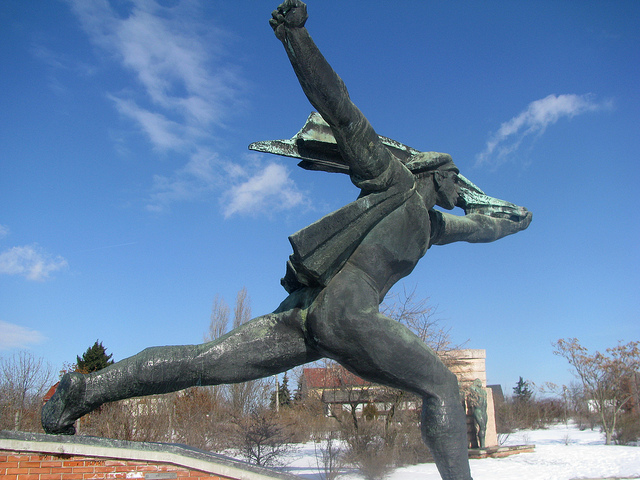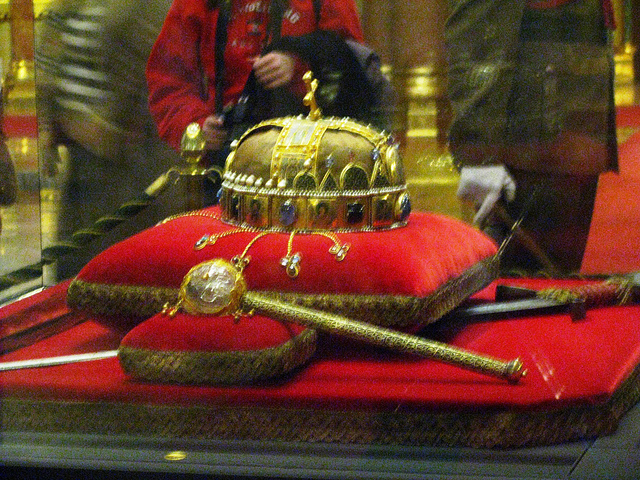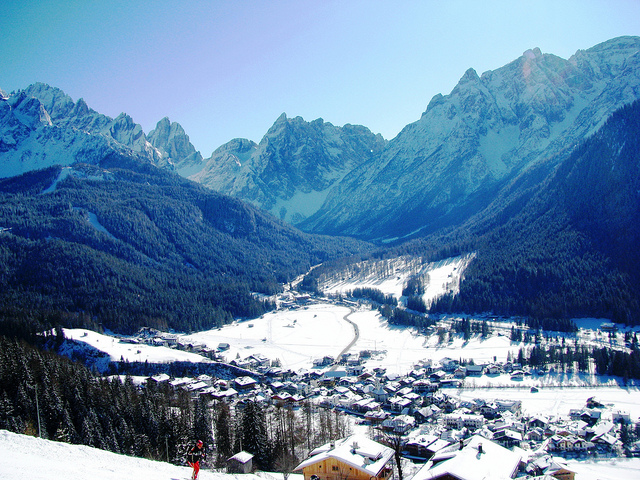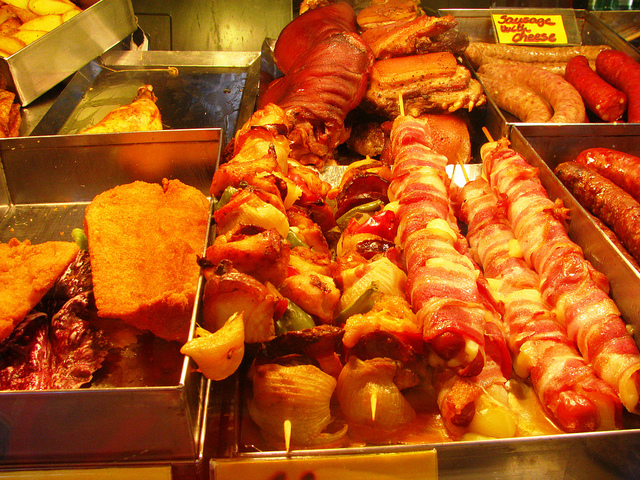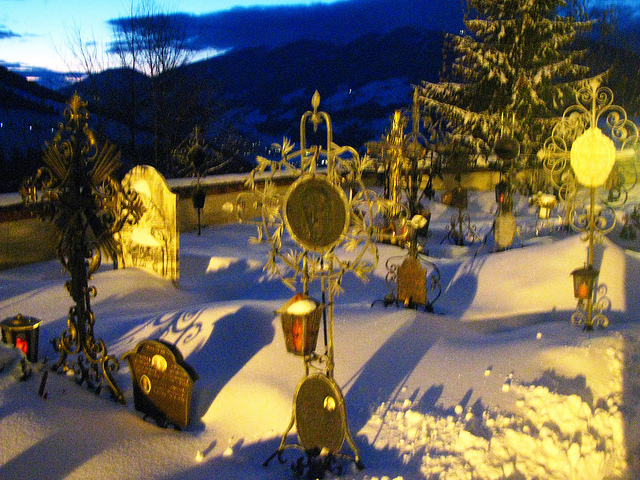After the snowy day yesterday, the sun was shining and the cool winter sky was radiating in brilliant hues of icy blue. I got up early to get ready for a densely packed sight-seeing program. My location near the Astoria metro station was literally across the street from the Erzsébetváros district of Budapest which is the historic Jewish quarter of the city. This historic neighbourhood was first on my list for a morning walk.
While crossing the underpass underneath Karoly Köruth Street, I stopped at one of the underground vendors that were selling baked goods and purchased a freshly baked croissant. It is always a treat to walk through Budapest’s metro stations because of the seductive smell of oven-fresh baked goodies.

Just a few steps away from that intersection I had reached Dohany Street, the location of Budapest’s Great Synagogue, also referred to as the Dohany Street or Tabakstrasse (Tobacco Street) Synagogue. The Byzantine-Moorish style building is the largest synagogue in all of Europe and it was still closed. I was planning to visit it in more detail tomorrow morning and just had a quick peek into the side and back yards.
From here I turned left onto Rumbach Street, which holds another old synagogue, the Rumbach Street Synagogue which seemed to look rather run down from the outside. Jews first arrived in Hungary in the 13th century and started to congregate in Erzsébetváros (or Elizabeth Town) during the 19th century. During the Second World War Hungary came under Nazi domination and the Jewish Quarter was turned into a ghetto in 1944. Countless thousands of people were deported from here to Nazi concentration camps and overall, about 600,000 Hungarian Jews fell victim to the Holocaust.

Erzsébetváros still has a number of kosher Jewish shops and restaurants to this day and there are many Jewish-owned shops and night spots in this area today. I slowly strolled up Kiraly Street and turned left onto Vasvary Street. I walked past the ornate façade of the Franz Liszt Academy of Music, which was built between 1904 and 1907 in the Secession Style. A giant statute of the famous composer adorns the area above the entrance portal.
Continuing my way north I hit Andrassy Street, Budapest’s biggest shopping street and a designated UNESCO World Heritage Site. I took the metro at the Oktogon Station, changed lines at Deak Ference Square and headed across town to the other side of the Danube to the Batthyany Square metro station. When I came out the bright sun greeted me and I found myself on a large square with several Baroque-era buildings. St. Anne’s Church with its twin towers , begun in 1740 and finally completed in 1805, overlooked the square on the south side and on the north side I was looking at St. Francis Wounds Church, consecrated in 1757.

The main reason I was here though was to catch a view of the other side of the Danube: I now had a perfect vista of the Hungarian Parliament Building, which up until now I had only seen at dusk or yesterday on a snowy and overcast day. I had specifically come here to Batthyany Square to admire this magnificent building, Hungary’s largest, in the full sunshine. It did not disappoint.
To get an even better up-close look of the Parliament Building, I took the subway back to the other side of the Danube and exited at Kossuth Lajos Square and started snapping pictures of the brightly lit neo-Gothic splendour of the Hungarian Parliament Building. All the Gothic-inspired turrets, spires, gables and gargoyles, so reminiscent of London’s Palace of Westminster, were sparkling in the morning sun.

I had to head back to Deak Ference Square for 11 am because I was planning to embark on a special sightseeing tour: Memento Park is an open air museum about 30 minutes south of downtown Budapest that houses a collection of 42 Soviet-era statues, including Lenin, Marx and Engels. This is one of the more off-beat destinations in Budapest, and given Hungary’s painful experience during the era of Soviet domination, it was something I definitely wanted to learn about, given my interest in Hungarian history.
Our young guide was very entertaining and well informed, and in her sarcastic way, she explained the historical concept of hard and soft communism that prevailed in Hungary from 1949 to 1989. The Russian dictator Stalin was much hated in Hungary, and after the 1956 Revolution, only the boots remained of the 8 m high statue of Stalin, a replica of which is one of the main displays in Memento Park. The populace of Budapest had taken out its anger on Stalin’s likeness and destroyed the rest of the statue.
Memento Park holds a variety of sculptures that pay tribute to the Soviet liberators of Hungary (“the Endless Parade of Liberation Monuments”); others depict various Communist leaders (“the Endless Parade of Personalities of the Workers’ Movement”) and many of them glorify the concept of the Soviet-style working class activists (“the Unending Promenade of Worker’s Movement Concepts”). The largest sculpture, representing a worker with dynamically outstretched legs and arms, is always the most popular with the crowds. Given its forward stretched position, it is often ridiculed as a bath attendant chasing after a customer to hand over a forgotten towel in a Budapest bath.

After inspecting the statues, I visited the small and very dark indoor museum at Memento Park. There I watched part of a movie about Hungarian secret police spy activities during the 1970s entitled “Secret Police Training Methods in Communist Hungary”. By 1:30 pm we were ready to head back to downtown Pest where I grabbed a quick lunch in a small restaurant. Then I embarked on a stroll on Vaci Street, Budapest’s historic shopping street.
The northern portion of Vaci Street is pedestrianized while vehicular traffic is allowed on the southern portion. Fashion boutiques, shoe stores, souvenir shops and various restaurants and bars are located side by side and this was a perfect opportunity to pick up a souvenir t-shirt from Budapest. Then I headed back north across Deak Ference Square to St. Stephen’s Basilica which I had already visited yesterday. Contrary to yesterday’s dull snowy atmosphere, I now got to see the full splendour of this imposing church in the bright afternoon sunshine.

My last major sightseeing destination for the day was City Park or Varosliget in Hungarian. I took the historic Metro Line 1 all the way to Szechenyi Fürdo and exited into large urban park where lots of locals were taking a walk on a sunny Saturday afternoon. I crossed a body of water that looked much like a moat and entered the medieval-inspired Vajdahunyad Castle. Originally built for the 1896 Millenium Celebration, this castle is actually an eclectic mix of Hungarian building styles that illustrates the evolution of the country’s architecture, including Romanesque, Gothic, Renaissance, Baroque and other details. The Museum of Agriculture can be found in the Baroque section of this astounding building which shows elements of more than 20 of Hungary’s most famous buildings.
I walked around the frozen lake which had been turned into a large ice-skating rink, and dozens of people were lining up in front of a Secession-era pavilion to put on their skates and get out on the ice. Then I had reached Hösok Tere or Hero’s Square which is a gigantic public space that is anchored by the Millenium Monument. Although only completed in 1929, this gigantic monument features a 36 m high Corinthian column crowned by the Archangel Gabriel who holds St. Stephen’s crown and the apostolic cross. Equestrian statues at the bottom of the column represent Prince Arpad and six Magyar warriors. Behind the column are two curved colonnades whose sculptures personify War and Peace, Knowledge and Glory as well as Labour and Prosperity.

Flanking the huge square on the north side is the Museum of Fine Arts, which holds Egyptian and Classical artifacts as well as German, Dutch, Flemish, Spanish, Italian, French and British Art. Graphic art and 19th and 20th century paintings round out the collection. Masters such as Pablo Picasso, Edouard Manet, Pierre Renoir, Paul Cezanne and Paul Gauguin are also represented here. On the south side of the street is the Mücsarnok Art Gallery, Hungary’s largest exhibition space. This Neo-Classical building was constructed in 1895 and holds many temporary exhibitions of contemporary paintings and sculptures.
City Park holds a variety of other attractions that I did not have a chance to see: among others, the Szechenyi Baths, the House of Terror Museum, the Franz Liszt Museum as well as a zoo. Time was unfortunately too short to see all of City Park and I made a mental note to spend more time here on my next visit to Budapest.

It started getting cooler in the late afternoon so I headed back to my room to warm up and get ready for a nice evening. A local friend of mine was going to meet me for dinner and she picked me up at 7 pm for a walk downtown. We were going to eat at a waterfront restaurant facing the Danube, but unfortunately her favourite restaurant was closed. Despite this minor disappointment, we enjoyed a phenomenal view across the wide river to the Royal Palace, the Elisabeth Bridge, the Matthias Church and the lit-up Chain Bridge. Budapest is a beautiful city to begin with, but it truly exudes its magic at night, when all the famous sights are illuminated.
So we walked back onto Vaci Street and picked a small local restaurant on a side street. I got to sample some delicious herbed chicken with crispy French fries, followed by a scrumptious chocolate covered pancake. Palaczintas, as they are called in Hungarian, are a big specialty here and given my Austrian upbringing, this type of comfort food is something that I greatly enjoy. At about 10:30 pm I said goodbye to my friend and thanked her for a really nice evening and headed back to my room to rest up for my final few hours of explorations in Budapest tomorrow morning.

